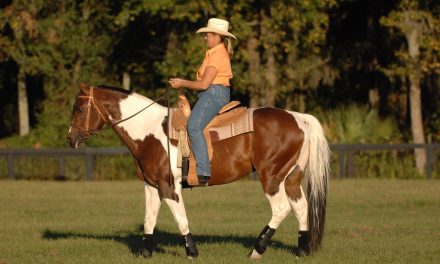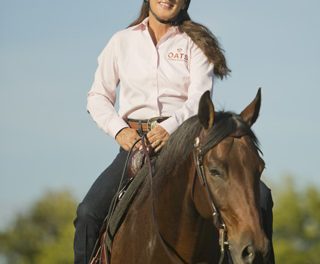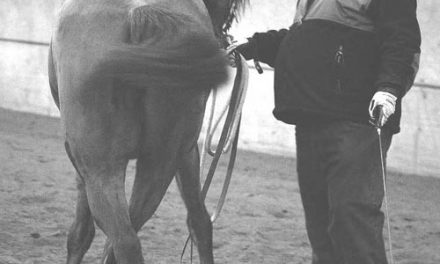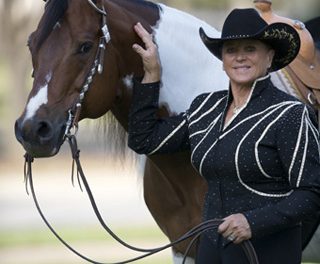Palm Partnership Training
Building a Partnership with Your Horse
 It probably comes as no surprise that a good walk is important in a trail horse. However, a horse with a comfortable, ground-covering walk is one that will be appreciated by real working cowboys, dressage riders, endurance and competitive trail riders, as well as weekend trail riders. That is because the walk is one of the hardest gaits to improve in a horse, and yet it is the gait most commonly used by most riders outside of speed events.
It probably comes as no surprise that a good walk is important in a trail horse. However, a horse with a comfortable, ground-covering walk is one that will be appreciated by real working cowboys, dressage riders, endurance and competitive trail riders, as well as weekend trail riders. That is because the walk is one of the hardest gaits to improve in a horse, and yet it is the gait most commonly used by most riders outside of speed events.
Although it is difficult to improve the quality of a horse’s walk, there are some exercises you can practice to teach your horse to walk at a comfortable, controlled speed in a straight line. When your horse is in a controlled walk, it is much easier for him to stay balanced when he is going up and down hills. If a horse is balanced and moving in a straight line, he can better transfer his weight to his hind end when going downhill as well as negotiate rough terrain much more easily.
Practice the following exercise in your regular tack in an enclosed area at first before you take it out on the trail. Make sure you are sitting balanced in the center of your horse’s back and that your cues are clear so that your horse understands them.
The Basic Walk
Many riders create problems unintentionally when they either kick or grip the horse’s side to get him to walk forward, but these two actions actually make the horse resist. Try pounding your ribs with your fist to get an idea of what your horse feels if you do this. Remember that a horse is sensitive enough to feel a fly land on his skin so he does not need much of a leg aid when you ask him to move forward.
Use your calves, and not your heels, in as light a touch as necessary to ask your horse to walk forward. If your horse does not step forward immediately into a walk, slide your calves slightly backward and ask again. If that doesn’t work, use a “clucking” sound with your leg aid or touch his side with your crop or the end of our reins just behind your leg or on his rump to give him even more encouragement to move away from the touch.
As your horse walks, practice staying balanced and let your hips move back and forth naturally as they follow his motion at the walk. This will synchronize you with the horse, and both you and he will be more comfortable. It also will encourage him to relax his back and use his hind legs more. You keep the horse moving straight and maintaining speed by using light support with your legs and reins.
You can tell if your horse is comfortable and relaxed in the walk if his ears are forward and he is moving along without resistance. If your horse is relaxed, clearly understands what you are asking of him, and trusts you, then he will be easier to work with and enjoy the ride too. If you are unbalanced or heavy-handed, however, your horse will be frustrated and anxious for the ride to be over with and may challenge you in some way.
There is less momentum at the walk to help your horse stay straight. If he is having trouble staying straight at the walk, practice transitions between the walk and the trot. Walk straight and at a steady pace—without slowing or speeding up. Next, practice varying your speed at the walk.
After practicing walking in a straight line, walk in circles at a steady pace. Remember, that when you circle your horse, he should have a slight bend or curve to his body and not have just his head turned to the inside.
Always be aware of your position in the saddle. Your spine should be centered over your horse and an observer should be able to draw a straight line from your ear to your shoulder to the middle of your hip, to the back of your heel, and down to the ground. Your eyes should always be looking ahead to where you want to go and not down at your horse.
Remember, if you have trouble controlling your horse’s speed at any gait, bring him into a turn because bending will automatically slow him down. At a walk, initiate the turn by using an upward motion with your outside rein only. This will shorten the horse’s stride at the walk. Think of your outside rein as your “brake.”
The material is taken from a series of articles I did for Trail Rider Magazine with writer Cynthia McFarland. Many trail-training lessons can be found in my book, Training Outside the Box. Find this, and other helpful training materials, at www.lynnpalm.com or call 800-503-2824.





